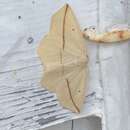Conservation Status
provided by University of Alberta Museums
The larva is a twig mimic, possessing several shallow warts on the thorax and on the abdominal segme
- license
- cc-by-nc
- copyright
- University of Alberta Museums
Cyclicity
provided by University of Alberta Museums
Adults fly from mid May to late June.
- license
- cc-by-nc
- copyright
- University of Alberta Museums
Distribution
provided by University of Alberta Museums
T. crocallata is predominantly eastern in distribution, and is at the western edge of its range in Alberta. South to GA and TX (Wagner et al. 2001).
- license
- cc-by-nc
- copyright
- University of Alberta Museums
General Description
provided by University of Alberta Museums
"A large pale-tan, geo, with the markings restricted to a straight transverse line from the apex to the anal margin of the forewing, a sharp, small discal spot, and a dusting of dark scales. Hindwings unmarked except for a faint discal spot.
The straight PM line and absence of other prominent wing markings will separate the two Tetracis species; T. cachexiata is much paler (cream-white), lacks a discal spot and the dusting of dark scales.
"
- license
- cc-by-nc
- copyright
- University of Alberta Museums
Habitat
provided by University of Alberta Museums
Deciduous and mixedwood forests, woodlands and shrubby areas.
- license
- cc-by-nc
- copyright
- University of Alberta Museums
Life Cycle
provided by University of Alberta Museums
"The larva is a twig mimic, possessing several shallow warts on the thorax and on the abdominal segments; colour is extremely variable, ranging from grey to brick, tan or brown. The pupa overwinters (Wagner et al. 2003).
The larva is a twig mimic, possessing several shallow warts on the thorax and on the abdominal segments; colour is extremely variable, ranging from grey to brick, tan or brown. The pupa overwinters (Wagner et al. 2003).
The larva is a twig mimic, possessing several shallow warts on the thorax and on the abdominal segments; colour is extremely variable, ranging from grey to brick, tan or brown. The pupa overwinters (Wagner et al. 2003).
"
- license
- cc-by-nc
- copyright
- University of Alberta Museums
Trophic Strategy
provided by University of Alberta Museums
McGuffin (1987) lists alder (Alnus sp.) and willow (Salix sp.) as larval hosts.
- license
- cc-by-nc
- copyright
- University of Alberta Museums
Tetracis crocallata
provided by wikipedia EN
- license
- cc-by-sa-3.0
- copyright
- Wikipedia authors and editors
Tetracis crocallata: Brief Summary
provided by wikipedia EN
Tetracis crocallata is a moth of the family Geometridae first described by Achille Guenée in 1858. It is found in North America from Nova Scotia, New Brunswick, southern Manitoba and southern Saskatchewan to Alberta, south to northern Florida, west to Kansas, Nebraska, North Dakota and extreme eastern Texas.
The length of the forewings 17–25 mm. Adults are on wing from May to August depending on the location. There are two generations in New York and southward.
The larvae feed on Alnus, Castanea and Salix species.
- license
- cc-by-sa-3.0
- copyright
- Wikipedia authors and editors

